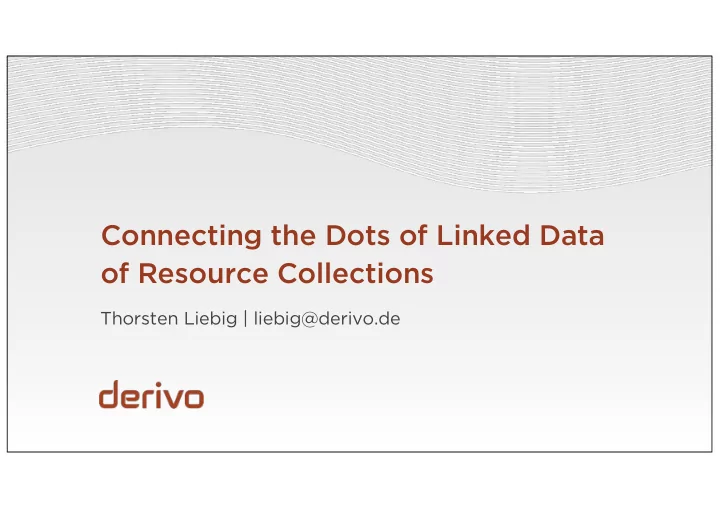

Connecting the Dots of Linked Data of Resource Collections Thorsten Liebig | liebig@derivo.de
www.derivo.de • SME, est. 2010 • Design and development of semantic software solutions • Expertise: Smart Data, Big Data and Semantic Technologies • OWLlink, OWL API • Clients: intelligence authorities machine engineering publisher
RDF Graphs Pro: • simplest possible structure • easy to produce, exchange, consume, ... • straightforward query language Con: • everything has to be a triple (reification is painful)
RDF Graphs Pro: • simplest possible structure • easy to produce, exchange, consume, ... • straightforward query language Con: • everything has to be a triple (reification is painful) • mix-up of data and schema
RDF Graphs Pro: • simplest possible structure • easy to produce, exchange, consume, ... • straightforward query language Con: • everything has to be a triple (reification is painful) • mix-up of data and schema
What’s in a RDF Graph? Jack has-son Female rdf:type Mike i rdfs:subClassOf s - s i b l i n g age age Sandra :Female rdf:type 28 rdfs:subClassOf Male Person
What’s in a RDF Graph? Schema (TBox) Data (ABox) • vocabulary of domain • data of the domain • vocabulary conform data Jack • object of queries • knowledge about domain has-nephew • contains inferred facts has-son • larger than schema and subject to updates Mike:Male i s - s i b l i n g Person age Sandra:Female rdfs:subClassOf 28 Male Female relative symmetric: is-sibling is-sibling has-son is-sibling ⊕ has-son ➜ has-nephew age [range: xsd:int]
How to Query and Visualize a RDF Graph? Jack SPARQL: has-nephew has-son SELECT ?x ?y WHERE { ?x a Female . ?x relative ?y . Mike:Male i s - s i b l i n g } age Sandra:Female 28 http://yasgui.org Person rdfs:subClassOf Male Female relative is-sibling has-son age [range: xsd:int]
How to Query and Visualize a RDF Graph? Jack SPARQL: has-nephew has-son SELECT ?x ?y WHERE { ?x a Female . ?x relative ?y . Mike:Male i s - s i b l i n g } age Sandra:Female http://www.irisa.fr/LIS/ferre/sparklis 28 Person rdfs:subClassOf Male Female relative is-sibling has-son age [range: xsd:int]
Faceted Search • http://www.cs.ox.ac.uk/i sg/tools/SemFacet/ • well known to users • allows logic operators (and/or) • focus on one result variable (when compared to SPARQL) • overview missing
Network Visualizations
SemSpect Interactive, data driven visualization and analysis via: • grouping of nodes • aggregation of relations • selective exploration • on-demand details • sophisticated filtering • http://www.semspect.de
Wrap-Up ▶ Lessons learned • business critical data is not always perfect • semantic modelling is not for free but pays off • don’t get confused by the triple heap ▶ Key factors for effective querying and exploring • user guidance wrt. schema and query syntax • scalability of visualization paradigm • user orientation and result interpretation • data-driven exploration options
Recommend
More recommend